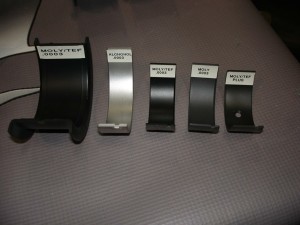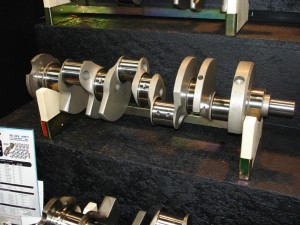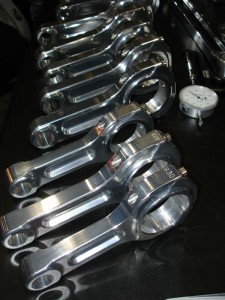The crankshaft, connecting rods and bearings are extremely important in every engine build, whether mild or wild, because they convert the reciprocating motion of the pistons into rotational torque. The longer the stroke, the greater the leverage effect and the greater the torque output of the engine. There are three things that need to be considered when replacing a crank, rods and bearings:
1. Strength — Are the parts going to be strong enough for their intended use? A circle track car, drag car or marine application will put far more strain on the crank and rods than a stock or street performance daily driver.
2. Bearing clearances — Are you going to build it loose or tight? Will the oil viscosity and pressure match the bearing clearances?
3. Balance — Absolutely critical for engine longevity regardless of the application or RPM potential of the engine. Even a small imbalance at low RPM over a long period of time can fatigue metal.
The correct length is vital when selecting connecting rods. Rod ratio is the length of a connecting rod (center to center) divided by the stroke of the crankshaft.
Durability
Stock engines and street performance engines are expected to last a long time: tens of thousands of miles if not a 100,000 miles or more. Combustion temperatures and pressures are lower in a stock engine than a performance engine, and RPM is usually limited to about 6,500 RPM or less. Consequently, a cast iron crankshaft, original equipment powder metal rods and standard bearings are usually adequate for their intended use.
Original equipment cast iron cranks are usually made of 1053 high-carbon alloy steel. This material has a tensile strength of around 100,000 to 110,000 psi, which can usually handle as much as 400 to 450 horsepower (depending on the engine and size of the journals). Forged cranks, by comparison, may be made from 5140, 4130, 4340 or other high grade alloy steels with tensile strength ratings from 115,000 psi up to 165,000 psi or higher (depending on the alloy and heat treatment). Essentially, you get what you pay for when you buy a high performance crank made of a high quality alloy.
Most of the forgings that are used in aftermarket performance cranks today come from China. The quality of the metal depends on the supplier and how the crank is heat treated. Some U.S. crank suppliers do their own finishing work and heat treatment on the Chinese-forgings they buy while others go with prefinished cranks. What’s really important here is not the source of the crank or the brand on the box but the quality that has gone into manufacturing and finishing the product. The journals on a high performance crank should be perfectly round and polished to specifications, and level side to side with no taper or convex or concave curvature. The location of the journals must also be accurately indexed for proper valve timing and ignition. The counterweights must also be in the right locations and have the proper mass to offset the reciprocating mass of the pistons and rods. As long as a crank meets all of these criteria, it should be a good, dependable crank.
Crankshafts can fail if they are subjected to more power than they can handle, and from metal fatigue. Asking a stock cast iron crank to handle more than 400 to 450 horsepower in a small block V8, or over 550 horsepower in many big blocks is asking for trouble. If the engine will be equipped with some type of power added (nitrous oxide, a turbocharger or supercharger), the demands on the crank will go up even more and likely require an upgrade to a forged or billet steel performance crank.
Do you want a light crank or a heavy crank? It depends on the application for which you are building the engine. Circle track cars are probably the most demanding on both the crank and rods because the engine is constantly on and off the throttle. If the rules allow it, a lightweight crank will provide better throttle response and allow the engine to rev and decel more quickly than a stock weight crank. On the other hand, if you are building an engine for a drag car, weight doesn’t matter because the engine will be running at full throttle for a quarter of a mile. The extra rotating weight will also add momentum that can help a car launch off the line without bogging.
Another point to keep in mind if you are building a blown engine is the extra stress the blower drive puts on the end of the crank. The added stress and flexing over time can lead to fatigue cracks and crank breakage, so look for a crank that is available with a larger diameter nose.
Choosing a rod depends on the application – you want a rod that’s strong enough to handle the power and RPMs the engine is capable of producing.
Upgrading Rods
Many late model engines are factory equipped with powder metal rods. The vehicle manufacturers like powder metal rods because they are much less expensive to manufacture. The rods can be cast to very close final tolerances and require less machining than a cast iron or forged steel connecting rod. There is no grain structure in a powder metal rod so the rods can be cracked to separate the cap from the rod. This is faster, easier and some say better than cutting and machining rod caps because cracking leaves a slightly jagged surface on the cap and rod which will only mate together one way. The advantage is that it provides perfect alignment between the cap and rod but the trade-off is that the cap and rod cannot be machined to correct for any bore distortion or wear that has occurred over time. Because of this, powder metal rods are essentially throwaways if the big end is worn or the cap has loosened up over time (which they do).
If you’re doing a performance build, therefore, one of the first parts that will have to be upgraded is the rods. Replace the original equipment powder metal rods with some type of aftermarket performance rod (I-beam or H-beam).
There are a lot of choices when it comes to aftermarket rods. Choosing a rod depends again on the application. You want a rod that’s strong enough to handle the power and RPMs the engine is capable of producing. You also have to match the rod length with the stroke of the crank, the pistons and pin location, and the engine’s deck height.
Strength is critical in a connecting rod. The forces that stretch and compress the rods exert tremendous stress on the beam section of the rod. If a rod is going to fail, it will most often pull apart on a piston upstroke rather than bend during a piston downstroke. A rod can also fail if the bearing starves for oil, seizes and rips the rod apart.
The stock rods in most V8s are stout enough to handle upwards of 400 to 450 horsepower, and 5,500 to 6,500 RPM. Exceed these limits and you’ll need stronger rods for reliability. One aftermarket rod supplier we interviewed for this article said his entry level rods can handle 800 to 990 horsepower, and his top end rods are running in engines producing upwards of 2000 horsepower. H-beam rods made of 4340 or 300M steel are commonly used in many circle track engines, while I-beam rods are popular with drag racers and marine engine builders. The debate of I-Beam versus H-Beam often boils down to a matter of personal preference.
Most Top Fuel dragsters and funny cars use aluminum rods in their motors. So do many ProStock racers. Aluminum rods have a limited service life because they can stretch and fatigue in high stress engines like these. Even so, they work well enough because the typical Top Fuel racer replaces the rods after 8 to 10 runs. ProStock racers may replace the rods after 20 or 30 runs. In the lower drag racing classes, a set of aluminum rods may last 100 to 200 runs or longer.
Aluminum rods can work on the street, but it requires a high quality alloy. For this reason, many engine builders prefer to stick with steel rods for their proven longevity.
Titanium rods are another option for those with deep pockets. Titanium is light weight (about 24% lighter than a comparable steel rod) and has about the same durability as a steel rod, but titanium is expensive and tricky to manufacture. If you can afford them, great! Otherwise, they are probably too expensive for the average street performance customer or weekend racer.
Rod length is another choice you will have to make when selecting a set of rods. Rod ratio is the length of a connecting rod (center to center) divided by the stroke of the crankshaft. Many performance engine builders say a rod ratio of 1.57 to 1.67 works best. A longer rod ratio can make an engine’s torque output peak more sharply. Lower rod ratios work well with lower RPM stroker motors while higher rod ratios are better suited for high revving engines.
Another option is to use rods that do not have wrist pin bushings. This leaves more metal around the wrist pin for added strength at high RPM. But it requires a highly polished pin hole and a low friction coating on the wrist pin to prevent the pin from galling.
The type of bolts used to attach the rod cap to the rod is also important. The stronger the bolts, the better. Poor quality bolts can stretch and allow the cap to wander, leading to rod and bearing failure.

Reducing the oil clearance between the rod and main bearings and the crankshaft has a number of advantages. A smaller gap spreads the load over a wider area of the bearing surface and distributes pressure more uniformly across the bearing.
Bearings
The bearings support the crank and bear the forces that are exerted by the rods as they reciprocate up and down. A thin film of oil is all that separates the bearing from the crank journals, so bearing clearances as well as oil viscosity and oil pressure must all be considered when building an engine for a particular application.
Traditionally, most performance engine builders have gone with “looser” bearing clearances (.0025 to .003 inches) for the rod and main bearings because it works well with 15W-40 racing oil and high pressure oil pumps. One crankshaft manufacturer said the larger the journals on the crank, the more bearing clearance you should allow so the oil can get all the way around the bearing. If you set the bearings too close, you run the risk of spinning a bearing.
On some applications, tight clearances work provided the right combination of shaft diameter, bearing clearance, oil viscosity and oil pressure is used. A tighter bearing clearance spreads the load over a slightly broader arc on the bearing whereas a larger bearing clearance will concentrate the load on a narrower strip of the bearing surface. Spreading the load across a larger area of the bearing is good in an endurance engine and street engine because it reduces metal fatigue and extends the life of the bearing.
Indy cars and NASCAR can get away with tight bearing clearances (.0015 or less) because many of these engines have smaller diameter cranks and they are using low viscosity 0W-40 or 5W-20 synthetic racing oils.
The crank journals also have excellent geometry and are finished to precise tolerances (which may not always be the case with a budget motor or a reground crank). The tighter clearances and thinner oil means less oil pressure is needed to keep the bearings lubed, so oil pressure can be reduced to cut the amount of power needed to drive a wet dump oil pump. Thinner oils also reduce friction which saves horsepower.
The disadvantage of thinner viscosity oils is that the oil can drain off the bearings more quickly. When a race car sits all week without running, the bearings may be dry when the engine is fired up. A heavier oil will cling to the bearings better, but will require more bearing clearance so it will flow around the bearings more easily.
It goes without saying that journal diameters and well as bearing fit should always be measured when assembling an engine. Never assume everything has been manufactured to specifications or has been boxed accurately. Mistakes happen!

The journals on a high performance crank should be perfectly round and polished to specifications.
Photo courtesy of Scat Enterprises Inc.
Balance Considerations
Whether an engine is internally balanced (usually preferred) or externally balanced, a good balance is essential for crank and bearing longevity. Imbalance in the rotating assembly creates shaking forces that can fatigue metal over time. The closer the balance, the better — even in engines that seldom if ever see the high side of 5500 RPM. Imbalance grows exponentially with engine speed, so the higher the engine revs the greater the force generated by even a small imbalance.
When choosing a replacement crank, you want to match the weight of the rods, wrist pins, pistons and rings to the counterweights on the crank.
All crankshafts have a target bobweight (plus or minus 2 percent typically) that approximates the weights of the pistons and rods that you plan to use. The closer the target bobweight of the crank is to the actual parts, the less time and drilling it will take to balance the crank.
Determining the bobweight requires weighing all of the parts. Rod weights tend to vary more than piston weights due to heavier mass.
With lightweight cranks or those where the outside diameter of the counterweights have been turned down to reduce weight, there may not be enough metal in the counterweights to completely offset the pistons and rods. This will require heavy metal tungsten (Mallory) plugs in the counterweights to balance the crank and possibly externally balance the engine with additional weight on the flywheel and harmonic balancer. Heavy metal adds cost as well as extra time and labor to balance the crank.
Most production V8 crankshafts have six counterweights to reduce weight and cost. This works well enough for most applications, including racing. But for high revving endurance engines and longer stroke engines, adding two additional counterweights for the center pistons allows better balance and reduces crank flexing that can lead to fatigue and crank failure.
Some cranks have holes drilled lengthwise through the main journals. This has no effect on balance and only reduces the overall weight of the crank maybe 2 or 3 lbs. The main purpose of these holes is to allow air to move back and forth in the crankcase as the pistons move up and down. On Chevy LS engines, this type of breathing is essential because the crankcase is very tight and restricts airflow between cylinders.
If you are installing a windage tray on a Chevy LS, the tray needs to be positioned far enough away from the crank so that it doesn’t inhibit this back and forth airflow within the crankcase.
The tray needs to be above the oil level in the pan so oil is whipped up by the spinning crank, but at least an inch or more away from the crank to allow good airflow.
A dry sump oil system that has enough suction to pull vacuum in the crankcase will solve such breathing problems by pulling out most of the air along with the oil.
The post Replacing Crankshafts, Connecting Rods and Bearings appeared first on Engine Builder Magazine.
Read more here: Engine Builder Magazine

